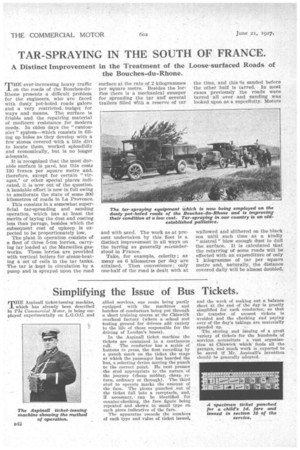TAR-SPRAYING IN THE SOUTH OF FRANCE.
Page 68

If you've noticed an error in this article please click here to report it so we can fix it.
A Distinct Improvement in the Treatment of the Loose-surfaced Roads of the Bouches-du-Rhone.
THE ever-increasing heavy traffic on the roads of the Bouches-duRhone presents a difficult problem for the engineers, who are faced with dusty pot-holed roads galore and a very restricted, budget for ways and means. The surface is friable and the repairing material of mediocre resistance for modern needs. In olden days the " cantontiler " system—which consists in filling up holes as they develop with a few stones covered with a litle dirt to locate them, worked splendidly and economically, but is no longer adequate.
It is recognized that the most durable surface is pave, but this costs 130 francs per square metre and, therefore, except for certain " virages," or other special places indicated, it is now out of the question. A. laudable effort is now in full swing to ameliorate the state of some 300 kilometres of roads in La -Provence.
This consists in a somewhat superficial tar-spreading and sanding operation, which has at least the merits of laying the dust and costing less than pavage, besides which the subsequent cost of upkeep is expected to be proportionately low.
The plant in operation consists of a fleet of three 5-ton lorries, carrying tar loaded at the Marseilles gasworks. These lorries are provided with vertical boilers for steam-heating a set of coils in the tar tanks. The tar is kept in circulation by a pump and is sprayed upon the road
surface at the rate of 2 kilogrammes per square metre. Besides the lorries there is a mechanical sweeper for spreading the tar and. several trailers filled with a reserve of tar and with sand. The work as at present undertaken by this fleet is a distinct improvement in all ways on the tarring as generally misunderstood in France.
Take, for example, celerity ; as many as 6 kilometres per day are attained. Then convenience; only one-half of the road is dealt with at
the time, and this is sanded before the other half is tarred. In most cases previously the roads were tarred all over and sanding was looked upon as a superfluity. Motors wallowed and slithered on the black sea until such time as a kindly " mistral" blew enough dust to dull the surface. It is calculated that the retarring of some roads will be effected with an expenditure of only 1 kilogramme of tar per square metre and, naturally, the distance covered daily will be almost doubled.




















































































































